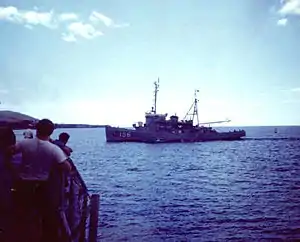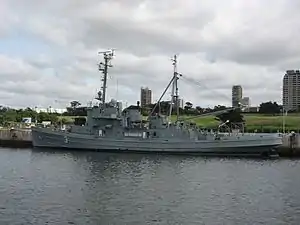USS Luiseno
USS Luiseno (ATF-156) was an Abnaki-class fleet ocean tug built for the United States Navy during World War II. Named after the Luiseño peoples (the southernmost division of the Shoshone Indians of California, who received their name from Mission San Luis Rey de Francia, the most important Spanish mission in their territory), she was the only U.S. Naval vessel to bear the name.
 | |
| History | |
|---|---|
| Name | USS Luiseno |
| Builder | Charleston Shipbuilding & Drydock Co. |
| Laid down | 7 November 1944 |
| Launched | 17 March 1945 |
| Commissioned | 16 June 1945 |
| Decommissioned | 1 July 1975 |
| Stricken | 1 July 1975 |
| Fate | Transferred to Argentina, 1 July 1975 |
 | |
| History | |
| Name | ARA Francisco de Gurruchaga (A-3) |
| Status | In active service as of 2017 |
| General characteristics | |
| Class and type | Abnaki-class fleet ocean tug |
| Displacement |
|
| Length | 205 ft (62 m) |
| Beam | 38 ft 6 in (11.73 m) |
| Draft | 17 ft (5.2 m) |
| Propulsion |
|
| Speed | 16.5 knots (19.0 mph; 30.6 km/h) |
| Complement | 8 officers, 68 enlisted men |
| Armament |
|
Construction
Luiseno was laid down on 7 November 1944 by the Charleston Shipbuilding & Drydock Company of Charleston, South Carolina; launched 17 March 1945; sponsored by Mrs. William J. Roth, Jr.; and commissioned 16 June 1945.
Service history
US Navy service
After shakedown, Luiseno operated out of Norfolk, Virginia and Boston before sailing for Florida 28 July. For the rest of the year she performed salvage and target towing services in the Florida/Cuba area. During the summer of 1946 the fleet tug made a cruise to Bremerhaven, Germany to tow a 350-ton crane to Cristóbal in the Canal Zone, arriving there 20 September. From 1946 Luiseno performed miscellaneous duties including target towing, salvage operations, and other vital services, along the east coast, in the Caribbean and from her home port, Newport, Rhode Island.
During the Cuban Missile Crisis in October 1962 she operated out of the Guantanamo Naval Base, ready to perform any duty for which she would be called. Luiseno removed aircraft wreckage from the 1966 Palomares B-52 crash for dumping in the Atlantic.[1]
Luiseno received the Navy Unit Commendation, Navy Expeditionary Medal (2-Cuba), American Campaign Medal, World War II Victory Medal, National Defense Service Medal, and the Armed Forces Expeditionary Medal (1-Cuba).
Argentine Navy service
Decommissioned and struck from the Naval Vessel Register on 1 July 1975, Luiseno was subsequently transferred to Argentina under terms of the Security Assistance Program and renamed ARA Francisco de Gurruchaga (A-3). She was still in service with the Argentine Navy as of 2009.[2]
Gurruchaga incident
On 19 February 1982, six weeks before the beginning of the Falklands War, an incident occurred that could have sparked a full-fledged war between Chile and Argentina during the Papal mediation in the Beagle conflict. ARA Gurruchaga was anchored at Deceit Island inside the Beagle zone under mediation in Vatican, ostensibly providing support for sports boats participating in the Rio de Janeiro-Sydney boat race. The Quidora torpedo Boat approached and ordered the Argentine ship to leave the area. She fired several warning shots when the Argentine craft refused to move, as other Chilean ships converged to the scene. Although originally ordered not to leave the area and to wait for Argentine warships to arrive, the Argentine patrol boat received new orders to proceed to port as it became obvious that the Chilean navy had no intentions of backing down.[3]
Falklands war
During the Falklands war, Gurruchaga was assigned to support Task Group 79.3, centered around the cruiser ARA General Belgrano. When Belgrano was torpedoed by the British submarine HMS Conqueror on 2 May 1982, she sailed from Ushuaia to participate in rescue operations. From a total of 770 crewmembers rescued, 365 were saved by Gurruchaga, whose powerful searchlights and low freeboard proved particularly useful in recovering survivors from their liferafts.[4]
Notes
- Melson, June 1967, p.36
- ARA official website – "Irigoyen" class Archived 14 April 2009 at the Wayback Machine
- W. Ben Hunt (1997). Getting to War: Predicting International Conflict With Mass Media Indicators. University of Michigan Press. ISBN 978-0-472-10751-3. Retrieved 10 April 2013.
- Rossiter, Mike (2007). Sink the Belgrano. Bantam Press. pp. 327–330. ISBN 978-0593058428.
References
This article incorporates text from the public domain Dictionary of American Naval Fighting Ships.
- "Luiseno". Dictionary of American Naval Fighting Ships. Retrieved 3 August 2007.
- "ATF-156 Luiseno". Amphibious Photo Archive. Retrieved 3 August 2007.
- Melson, Lewis B., CAPT USN (June 1967). "Contact 261". United States Naval Institute Proceedings.
{{cite journal}}: Cite journal requires|journal=(help)CS1 maint: multiple names: authors list (link)